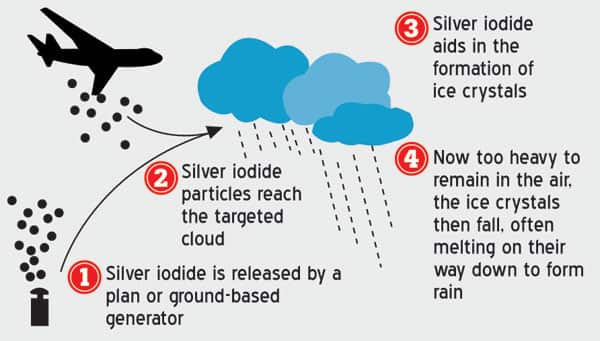Apparently, there have been many researchers who have been looking for ways to control rain, or make artificial rain, especially to help areas that are often hit by drought or forest fires.
In history, there have been various experiments to manipulate rain. One of them is cloud seeding.
Cloud Seeding
Cloud seeding is done by spraying microscopic particles such as aluminum oxide and silver iodide which affect the condensation process which acts as an artificial ice core.
Later, these compounds will provide the ability to form ice crystals.
This method was discovered by Dr. Bernard Vonnegut in 1971.
It uses silver iodide because it has a crystal structure similar to ice.
Cloud seeding methods have been used throughout the world, including the United States, United Arab Emirates, China, India and Russia.
The disadvantage, this method requires certain types of clouds and the surrounding air contains a certain percentage of water vapor.

The answer is very simple. For successful cloud seeding to bring rain it needs clouds with moisture to begin with.
Australia currently lacking both of them, and even if more clouds begin to appear in the Australian sky, they are most likely not the right type of cloud.
Steven Siems, cloud expert from the School of Atmosphere and Earth Environment at Monash University, said that seeding is only effective if used on clouds that contain very cold water drops (between -5 and -10 degrees celsius) that fail to convert to ice but are too small to falls as rainfall.
Cloud Type: orthographic
In Australia, there are usually many orthographic clouds formed by mountainous terrain that forces air to rise.
So, this method also requires mountains to bring rain.
And the mountains must be located in a pure atmosphere, by that reason seeding clouds is also not an option to extinguish forest fires.
Cloud Seeding in Indonesia
The Meteorology, Climatology and Geophysics Agency BMKG said the great flood that hit Jakarta in early 2020 was "one of the most extreme rain events" since records began in 1866, namely
The agency said climate change had increased the risk of extreme weather and warned that high rainfall could last until mid-February, with January 11-15 the expected peak.
After the massive floods that hit Jakarta, the Indonesian government tried to control rainfall by using a cloud cover method in an effort to break the clouds before reaching Jakarta.
This method is not always 100 percent successful, but is known to have a high probability of success.
However, the workings of nature remain beyond our control, humans. At least we know that in this world several techniques have been found which can more or less manipulate environmental / weather conditions.
Source: Australian Geographic
Share
